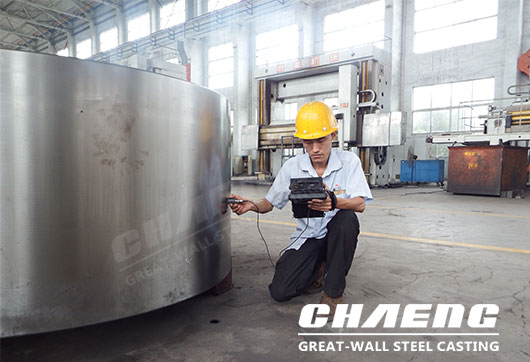Newsroom
Why do large steel castings need to be inspected?
2021-03-18 | Editor:
Which inspections are required for large steel castings? It mainly includes size inspection, appearance, and surface, composition analysis, performance inspection, etc. For some castings that require more important requirements or are prone to problems in the casting process, non-destructive testing is required.
 1. Quality testing equipment for steel castings: mainly used to detect quality problems such as alloy properties, structure, and surface conditions.
1. Quality testing equipment for steel castings: mainly used to detect quality problems such as alloy properties, structure, and surface conditions.
2. Nominal weight inspection of castings: It can be calculated according to the casting drawing or can be provided according to the qualification standards that both parties have approved, and the final casting weight is set, which also includes machining allowances and other process allowances.
3. Tolerance inspection standard for the weight of large steel castings: used to represent the percentage of the nominal weight of the casting to indicate the actual weight of the casting and the large allowable value of the difference between the nominal weight. This can be used to classify to express clearly.
4. Weight deviation: There will be a positive or negative deviation between the weight of the casting and the nominal weight.
5. Dimensional tolerance: the dimensional deviation of each part of the casting.
6. Dimensional stability: During use or storage, the original size should be maintained.
7. Machining allowance: The machining size of the casting and the precision of the parts can increase the thickness of the metal cutting layer of machining during the design of the casting process.
8. Surface roughness: check the microscopic geometric features composed of relatively small distances and peaks and valleys on the surface of large steel castings.

2. Nominal weight inspection of castings: It can be calculated according to the casting drawing or can be provided according to the qualification standards that both parties have approved, and the final casting weight is set, which also includes machining allowances and other process allowances.
3. Tolerance inspection standard for the weight of large steel castings: used to represent the percentage of the nominal weight of the casting to indicate the actual weight of the casting and the large allowable value of the difference between the nominal weight. This can be used to classify to express clearly.
4. Weight deviation: There will be a positive or negative deviation between the weight of the casting and the nominal weight.
5. Dimensional tolerance: the dimensional deviation of each part of the casting.
6. Dimensional stability: During use or storage, the original size should be maintained.
7. Machining allowance: The machining size of the casting and the precision of the parts can increase the thickness of the metal cutting layer of machining during the design of the casting process.
8. Surface roughness: check the microscopic geometric features composed of relatively small distances and peaks and valleys on the surface of large steel castings.
Order online
Fill out your message and submit it . Options with * must be filled in.
Prev:High-quality rotary kiln support roller manufacturer CHAENG
Next:CHAENG rotary kiln girth gear received good remarks from global customers
PRODUCTS
CONTACT
- Tel: +8615290747879
- Whatsapp: +8615290747879
- E-mail: casting@chaeng.co
- Skype : GreatWall1958


